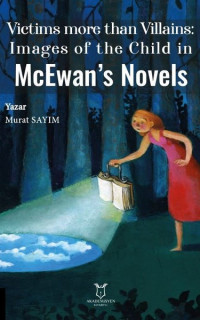
McEwan's Novels - Victims more than Villains: Images of the Child in
| ISBN | 9786258259285 |
| Yayınevi | Akademisyen Kitabevi |
| Yazarlar | Murat Sayım (author) |
| Kitap Tanıtımı | This dissertation aims to examine the situation of the child characters in a social and domestic context where the adult dominancy is currently superior in McEwan’s novels. The importance of this dissertation derives from connection between British contemporary literature and children in literature. It employs the concept of exploitation of child characters by adults’ authority as a generic theme in which perverse attitudes, vanishing and early deaths and intruding into the adult world of the children are questioned as a self defence to be able to cope with the pre-established adult impositions or as a protection of any other person who is under threat. My intention is not to absolve the child characters’ potential to do harm but to underline and scrutinise at under what circumstances a child becomes evil? Since the old beliefs such as either the children are innately good or innately evil have been deconstructed earlier; I believe that the stimulative forces to be human or inhuman are mostly related to the individual’s social conditions and his/her interaction with the society around him/her. All of the child characters I have discussed so far are portrayed in such a world where the adults are dominant at all hands. This dominancy and the adults’ need of continuation of their pre-established social and political system keep going at the cost of sacrificing the children. Children, in this sense, are both the sustenance and a barrier for the adults’ system. That’s why, probably the child image is seen as a social threat while, and on the other hand s/he keeps his /her naivety and victimised situation in adults’ hands. As a reaction to the adult oppression, the child characters seem to create their own self-protective mechanism against the adults’ power on them. Nevertheless, their self-protective attitudes are first labelled as villainous and sinister attitudes and then they are tried to suppress by the relevant authority of adults. In this sense, to be able to prove my argument Ian McEwan’s novels are appropriate since he uses the child images as a vehicle to criticise the social and political system of England. Therefore, his novels give us good opportunity to investigate the child images where they are mostly portrayed as medium in the adult world. The child characters of Ian McEwan are neither far away from the adult community as a symbol of utopia, nor so closely penetrate into the adults’ lives as needy creatures; they are narrated as individuals who can act just as in an adult capacity. McEwan, in other words, portrays his child characters in a huge potential and capability to do everything depending on the circumstances of the social context. He in a way liberates them. This flexibility at characterizing a child image gives us a good opportunity to investigate the children more objectively in his fictions. Because of the voiceless situation of the child figures in literature, they will always be narrated by adults, with a cost of being a medium in the hands of adult oppression. This scope for sure may be extended by adding other texts which include child images in literature and also by focusing on the patriarchal influence on children. (Tanıtım Bülteninden) ) |
Kütüphaneniz